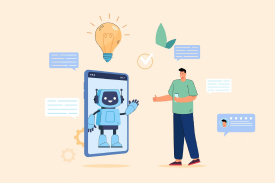The Role of AI in Modern Conversations: Changing the Way We Communicate

Remember when a conversation was just people talking? Is it almost quaint now? Whether it was hashing things out over coffee, a quick phone call, or even sending a letter (remember those?), it was purely human. But step into today, and there’s a new voice joining the chat—artificial Intelligence.
It’s no longer some far-off sci-fi concept; AI is subtly (and sometimes not-so-subtly) changing how we connect, ask questions, and get things done. The role of AI in communication is becoming massive, and honestly, how AI communication is changing the way we communicate is one of the most significant shifts happening right now. So, what is this tech about, and how is it weaving into the everyday chatter we barely think twice about? Let’s unpack that.
So, Really – What is Conversational AI?
You hear the term thrown around a lot: Conversational AI. But what is conversational AI when you strip away the jargon? Think of it as the brains behind the chatbots and virtual assistants you bump into online or on your phone – the ones you can talk to.
We’re not talking about those old-school bots that spat out pre-programmed answers. No, today’s Conversational AI is much smarter. It uses fancy tech like Natural Language Processing (NLP) and Machine Learning (ML) to determine what you mean, not just what you type or say. It gets the context, the intention.
That’s the key difference, and it’s why these AI-powered conversations feel so much more helpful (most of the time!). Understanding this deeper capability is essential to grasping AI’s evolving role in communication.
How Does This Digital Chit-Chat Happen? A Peek Behind the Curtain
It feels smooth when it works well, right? But how does conversational AI work? It’s a bit like a rapid-fire sequence of digital translation and decision-making:
- Listening In: First, it takes your input—maybe you type or speak a question. If it’s voice, it quickly translates the sound into text (Automatic Speech Recognition, or ASR).
- Getting the Gist (NLU): This is where the real intelligence kicks in. The AI uses Natural Language Understanding to figure out what you want. Are you asking for information? Trying to buy something? Complaining? It identifies your goal (intent) and identifies the significant bits (like product names, dates, etc.). Figuring out what conversational AI is often comes down to understanding this crucial NLU piece.
- Deciding What’s Next: It thinks it knows what you want. Now, the ‘Dialogue Manager’ part figures out the best response. Should it answer directly? Would you like more details? Should it pass you to a human? It tries to keep the AI conversation flowing logically, sometimes even remembering what you mentioned earlier.
- Talking Back (NLG): It needs to craft a reply in plain English (or whatever language you use). Natural Language Generation helps it construct sentences that sound natural and make sense in the context.
- Delivering the Message: Finally, it shows you the text reply or uses Text-to-Speech (TTS) to speak it back to you.
And boom! This whole cycle happens in seconds, allowing for the back-and-forth of AI-powered conversations. Knowing how conversational AI works makes you appreciate the complexity behind even simple bot interactions.
More Than Just Bots: AI’s Wider Influence on How We Talk
While chatbots get a lot of attention, the role of artificial intelligence in business communication is much broader. Seriously, think about it:
- Instant Translation: Need to chat with someone overseas? AI tools tear down language barriers in real-time. Suddenly, the world feels a bit smaller.
- Help for Everyone: Voice-to-text on your phone? Predictive text finishing your sentences? Screen readers? AI is behind many tools that make communication accessible to people with different needs and abilities.
- Cutting Through the Clutter: Drowning in emails? AI can help draft replies or summarize lengthy reports. It’s like having a super-efficient assistant for specific communication tasks. The purpose of AI in communication here is often pure efficiency.
- Reading the Room (Digitally): AI can analyze text (like reviews or social media comments) to determine the general feeling or sentiment. Businesses use this to understand customer happiness, but it has wider applications.
It’s clear that AI has already changed communication, making it faster and more inclusive and sometimes giving us insights we wouldn’t have otherwise.
AI Gets Down to Business: Reshaping Company Communication
In the business world? AI isn’t just a cool extra; it’s becoming a core part of the strategy. Artificial intelligence’s role in business communication transforms how companies interact, both outside and in. They’re using AI-powered conversations to get ahead:
- Customer Service on Overdrive: This is a big one. Conversational AI for customer service means help is available 24/7. It handles the easy questions instantly, deals with many customers at once, and lets human agents tackle the tricky problems. Happy customers and a more efficient team are win-win situations. You’ll find countless conversational AI examples right here.
- Sales & Marketing Smarts: Imagine a bot that not only answers product questions but also qualifies potential customers, suggests things you might like, and nudges you towards making a purchase. Artificial intelligence’s role in business communication is to make sales smoother and more personal.
- Helping from the Inside Out: It’s not just about customers. Conversational AI for enterprise includes internal helpers. Think HR bots answering policy questions, IT support bots troubleshooting common issues, or onboarding assistants for new hires. It just makes internal processes less painful.
- Learning from Every Chat: Every AI conversation is a piece of data. Innovative businesses use AI to sift through these interactions, spotting patterns, understanding what customers want (or hate), and finding ways to improve.
Using the right conversational AI software is becoming crucial. Conversational AI is transforming customer interactions regularly. The benefits of conversational AI for businesses are compelling: saving money, working faster, keeping customers happier, and getting smarter through data.
The Real Benefits of Conversational AI
So, why are we seeing this tech pop up everywhere? Because the benefits of conversational AI are pretty hard to ignore:
- Always On: AI doesn’t need breaks or sleep. Help is there whenever someone needs it.
- Handles the Crowds: Got a sudden rush of inquiries? AI scales up instantly without breaking a sweat—humans, not so much.
- Smarter Spending: Okay, there’s an upfront cost (we’ll get to how much conversational AI costs), but over time, automating routine tasks can save serious cash on staffing and training.
- Faster Work: AI zips through repetitive tasks, freeing people for tasks that require creativity, empathy, or complex problem-solving. It boosts overall efficiency.
- Plays by the Rules: AI delivers information consistently and follows procedures exactly, every time—fewer mistakes.
- It Knows You (Sort Of): Good AI can use past interactions to make the current conversation more relevant and personalized.
- Data Goldmine: AI-powered conversations provide valuable insights into what people ask for and how they feel.
These benefits of conversational AI add up, making a strong case for why the purpose of AI in communication technology is growing.
Common Conversational AI Examples
Have you not used Conversational AI lately? Think again. Here are some everyday conversational AI examples:
- Your Pocket Assistant: Siri, Google Assistant, Alexa. Asking for the weather, setting a timer, playing a song? That’s Conversational AI in action. It’s often our first lesson in how to talk with artificial intelligence.
- Website Pop-ups: Need help finding something on a shopping site? That little chat window is often an AI ready to assist, a classic example of conversational AI for customer service.
- Banking Bots: Are you checking your balance or asking about a recent transaction via chat? Increasingly, AI is handling the request.
- Health Helpers (Basic): Bots that help schedule doctor’s appointments or remind you to take meds are becoming more common (though they don’t replace a real doctor!).
- Travel Planners: AI assistants can guide you through booking flights and hotels, simplifying the process.
- Study Buddies: Some educational platforms use AI tutors to answer student questions and provide interactive exercises.
These conversational AI examples show just how integrated this tech already is.
The Toolkit: Understanding Conversational AI Platforms and Software
How do businesses build these things? They don’t usually start from zero. They use a conversational AI platform. Think of this as the foundational toolkit—it provides the core technologies (like the NLU engine, dialogue tools, and ways to connect to other systems) needed to create and manage AI agents.
There’s a whole market of conversational AI software options, from simple DIY builders for basic bots to compelling systems designed for big companies (conversational AI for enterprise). Picking the best conversational AI platforms depends on a business’s needs—how complicated the conversations need to be, what other software it needs to connect with, how many users it expects, and, of course, the budget.
Many vendors also offer conversational AI services, which help with planning, building, and maintaining the AI, especially for complex projects. These platforms and services are the backbone of the AI conversation revolution and shape the future of conversational AI.
How Much Does Conversational AI Cost?
Let’s talk money. Businesses always want to know: How much does conversational AI cost? Factors that swing the price tag include:
- How Smart Does it Need to Be? A simple bot answering basic FAQs? Relatively cheap. A complex AI integrated with your entire company database? Much pricier.
- Which Tools? Different conversational AI platform providers have wildly different costs—monthly fees, per-interaction charges, etc. Some even have free basic versions.
- Custom vs. Off-the-Shelf: A unique, custom-built solution costs more than a ready-made one.
- Playing Nice with Others: Making the AI talk to your existing CRM or sales software adds cost and complexity.
- Keeping it Sharp: AI isn’t “set it and forget it.” It needs updates, monitoring, and new data to stay effective.
- Where does it live? Does it support chat on your website, app, Facebook, and via voice? Each channel adds to the cost.
So, the cost of conversational AI can range from practically free for simple tools to well into six or seven figures for central conversational AI for enterprise projects. It’s less of a cost and more of an investment to weigh against the potential payoff from the benefits of conversational AI.
Chatting with Code: Tips on How to Talk with Artificial Intelligence
Okay, so we’re interacting with AI more. But how do we get the most out of it? Knowing how to talk with artificial intelligence can make the experience less frustrating and more productive:
- Keep it Simple (Mostly): Clear, straightforward language usually works best. Avoid obscure slang or overly complicated sentences.
- Natural is Good: You don’t need to talk like a robot to a robot. Use normal sentences.
- Context is King: If you’re asking a follow-up question, clarify what you’re referring to. Good AI remembers, but clarity helps.
- One Thing at a Time: If you have a complex request, try breaking it down into smaller steps or questions.
- Try Again, Differently: If it misunderstands, don’t just repeat the same thing louder! Rephrase your question slightly.
- Know Its Limits: Remember, it’s code and data, not a person. It doesn’t feel or understand in the human sense, so don’t expect genuine empathy.
Getting better at talking with artificial intelligence makes these tools more useful in our daily lives.
What’s Next? Gazing into the Future of Conversational AI
This field is moving fast. The future of conversational AI looks even more integrated and intuitive. What can we expect?
- More ‘Human’ Chats: AI will improve its ability to detect subtle meanings and tone and even show (simulated) empathy, making AI-powered conversations feel more natural.
- AI Taking the Initiative: Instead of just reacting, AI might offer help or suggestions before you ask. It may be creepy, but it could be potentially beneficial.
- Beyond Text and Voice: Conversations might blend text, voice, images, and even video seamlessly.
- Everywhere AI: Expect Conversational AI to be baked into even more software, websites, cars, and appliances. It’ll just be there.
- Super-Personalized Help: Interactions will be tailored more precisely based on your history and preferences.
- The Ethics Question: As AI becomes more powerful in AI conversations, conversations about fairness, bias, privacy, and transparency will become even more critical.
The future of conversational AI points towards a world where talking to technology feels almost exactly like talking to a person, further transforming how AI communication is changing the way we communicate. It cements the vital role of AI in communication.
Wrapping Up!
So, there you have it. Artificial Intelligence isn’t just knocking on the door of our conversations; it’s pulled up a chair and joined in. From figuring out what conversational AI is and how it works to seeing real conversational AI examples and the tools like conversational AI software that make it happen, it’s clear this isn’t a passing fad.
The role of artificial intelligence in business communication is particularly massive, driving efficiency through conversational AI for customer service and beyond. Understanding and adapting to this ever-growing role of AI in communication isn’t just smart; it’s becoming essential to how we’ll all talk, work, and live.




